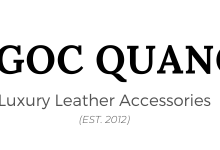Full Grain Leather Guide: All You Need To Know – Nội dung cập nhật 2024
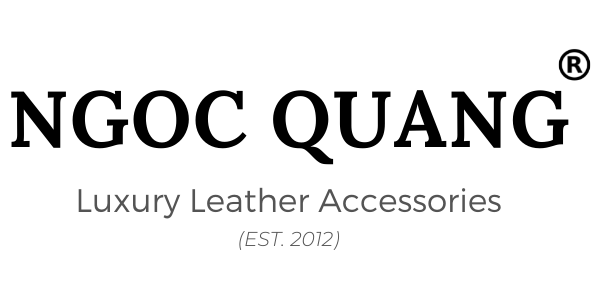
Tiêu đề nội dung
Tạp chí công nghệ da, sản phẩm thuộc da, chia sẻ kiến thức chuyên ngành da thuộc, cập nhật các xu hướng thời trang và đặc biệt giúp bạn lựa chọn đồ da (túi da, ví da, thắt lưng da, cặp da, giày da,…) và công nghệ sản xuất da thuộc tiên tiến.
3+ Full Grain Leather Guide: All You Need To Know cập nhật kiến thức mới nhất 2024
Growing up, I never understood why some of my leather products outlived others when they were otherwise treated the same. Turns out, the leather products I bought were split grain leather, cheaper products, or imitation leather. The nice things my distant, wealthier side of the family owned were full grain leather (which perhaps explains why when I was paid to wash their cars, they made me use four extra cleaning products I never even knew existed).
So, as it turns out, there are many types of leather. They each have different names, which refer to the area of the hide from which the leather is taken. Full grain leather, however, is the cream of the crop, the best you can get.
While some think the term “full grain” implies a grainy appearance, it does not. It actually refers to the fact that you have the entire hide, with every layer, intact and without any sanding.
Bottom Line Up Front
Authentic full grain leather is the best type of leather there is. Where you might see “leather” products that are actually split grain or top grain, full grain leather is not made from just a portion of the hide; it’s the whole thing. This makes it stronger, more durable, and long-lasting. If you invest in good full grain leather products, invest in some cleaning and conditioning products for long-term care.
Three Leather Types
When you look at a piece of rawhide, it is comprised of three parts:
- The first layer is the fleshy layer right below the hair, with the tightest, strongest fibers.
- The second is the thickest. The fibers here have an open structure that makes a cushioned barrier. This, on its own, is called split leather.
- The third layer is the grain of the hide, so it is referred to as grain leather.
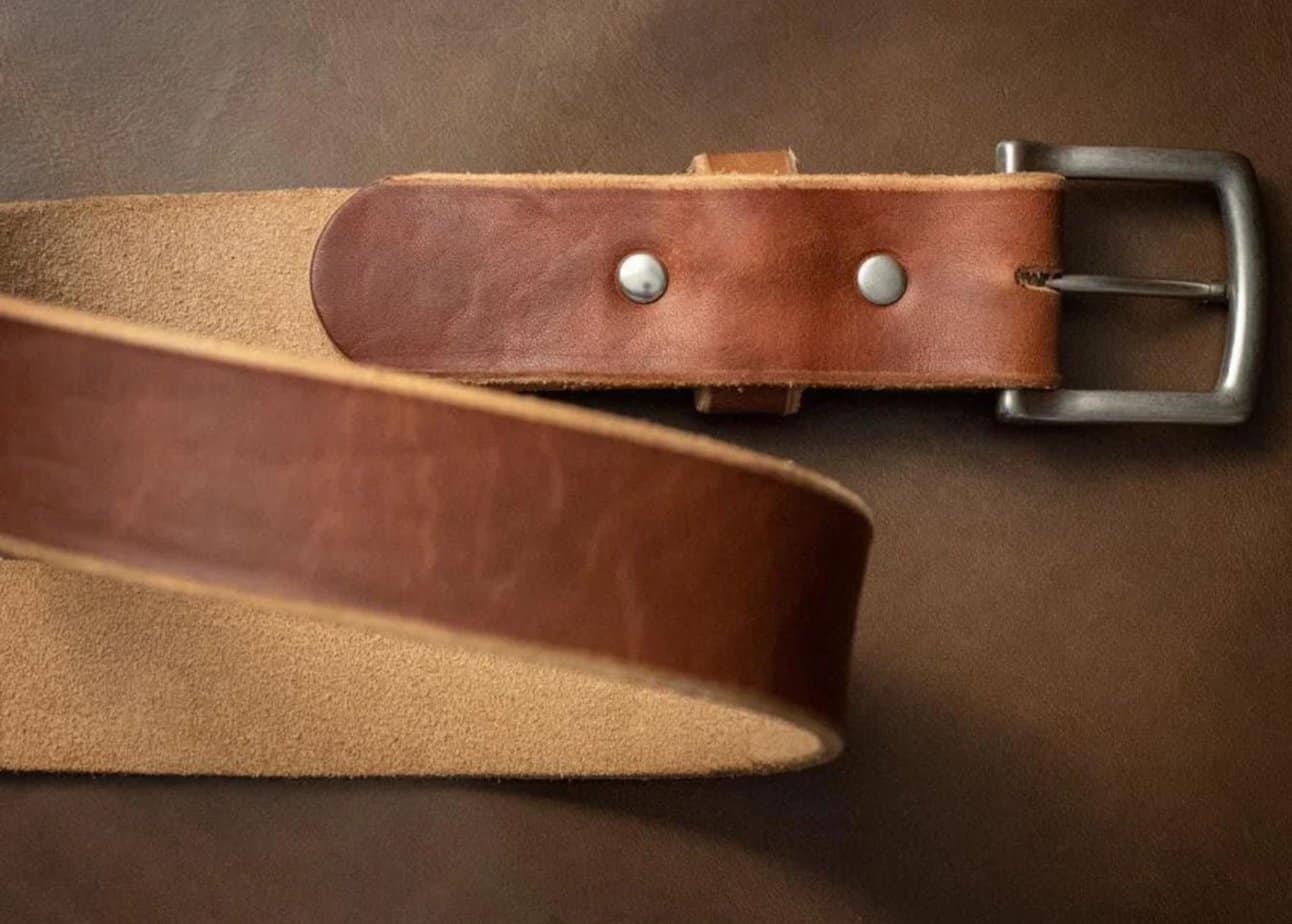
Some manufacturers split these layers, which is how you get what is called “split grain” or “split leather.” Splitting the layers means it is easier to work with and gives manufacturers more bang for their buck (they can make two products out of the same piece of hide). Still, it also compromises the structural integrity of the complete hide and changes its appearance.
Choosing not to split the layers gives you the entire hide, with all its strength and durability. This is called full grain leather because it has all of the layers down to the grain of the hide.
Full Grain Leather
Full grain leather is the most durable part of a hide, the part right below the hair. So, once the hide is used for leather goods, that durability is translated to particularly strong and long-lasting products. Full grain leather is not sanded or buffed, so it looks as natural as possible.
Full grain leather gets its durability and strength from tightly linked fibers. You can get full grain leather from any animal, including common cows, pigs, sheep, and even more exotic fare like an alligator.
The leather fiber left alone means it is stronger and more durable. With time it also develops a patina. A patina is a change in color with time. You might see the word thrown about in the world of classic cars where refinishing companies put a clear coat over the slight rust and exposed steel of an antique car just to show off the natural color changes.
If you look carefully at this used Coach bag, in between the pebbling finish, you will see the full grain leather with some natural color changes and markings, the much-sought-after-patina of genuine, full grain leather.
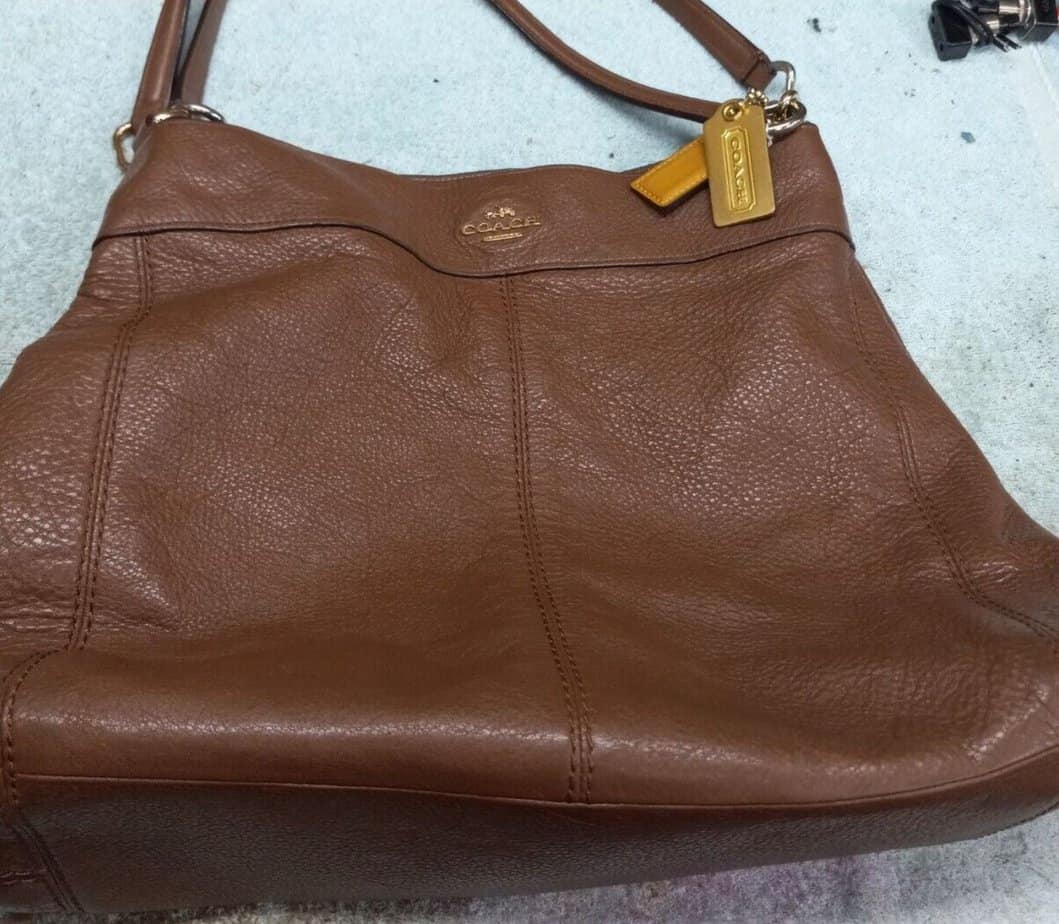
This patina means, over time, you see natural variations like wrinkles or lines and follicles and pores in the hide.
What to Look For
If you ever see something called “genuine leather,” this simply means it is genuinely a part of the leather or hides. It does not mean it is all three sections. High-end manufacturers like Burberry or Coach will specify whether their leather products are one of the three or all three.
If you dig into the characteristics or product descriptions, rest assured that companies offering authentic full-grain leather products will ensure you know it immediately. You shouldn’t have to read far to find information on the quality of the leather.
Companies that are using only split or top grain leather might be more insidious about their descriptions, with words like “genuine” thrown around a lot. So, if you don’t find the words “full grain leather” or “100% full genuine leather”, you might not be getting the real deal.
Pebbled or Embossed
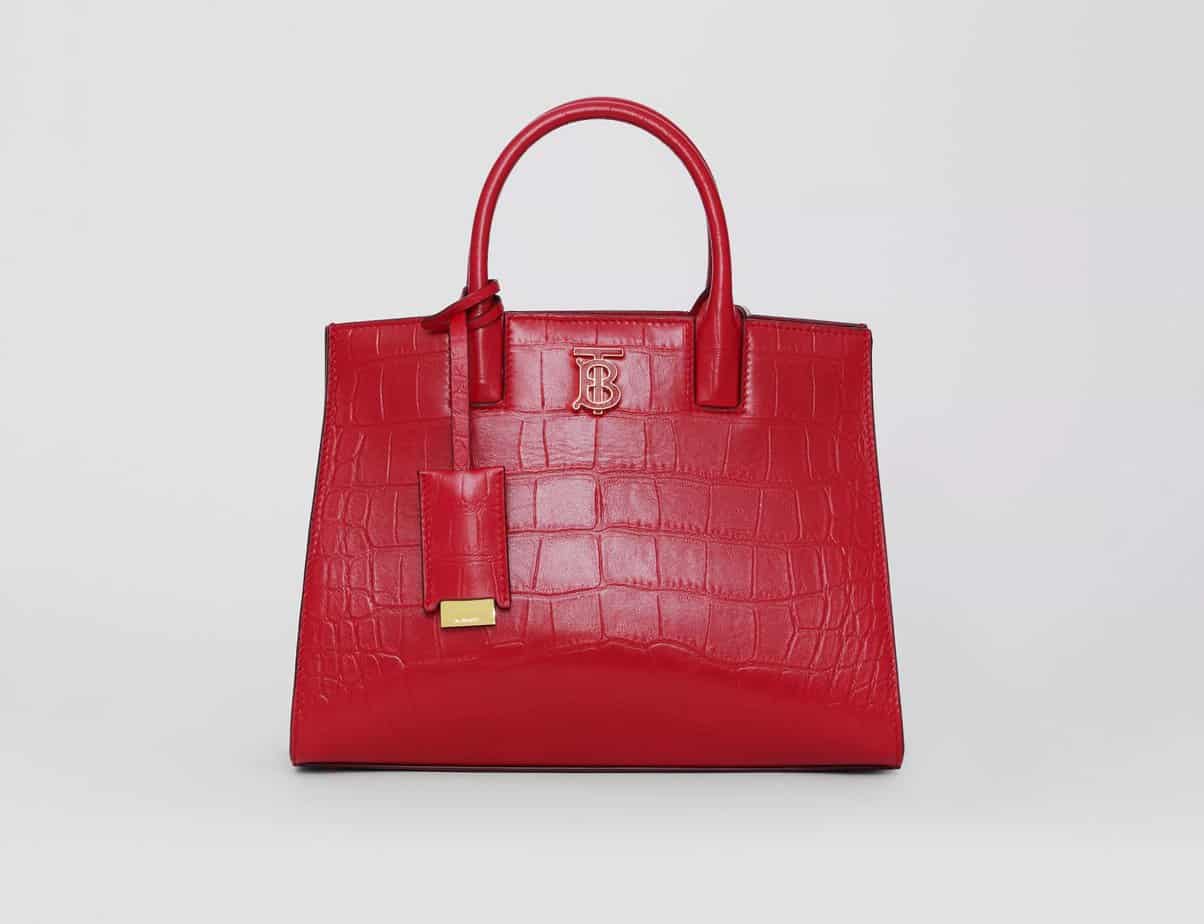
Full grain leather products can be pebbled or embossed, like this Burberry bag. With pebbling, a pebbled texture is embossed onto the surface. Usually, this is done to hide a natural flaw (like a bug bite or scar) in the hide. Embossing is typical of lower quality and split leather to disguise it, but it can also be found on full grain leather, as is the case with the Burberry line.
Burnished
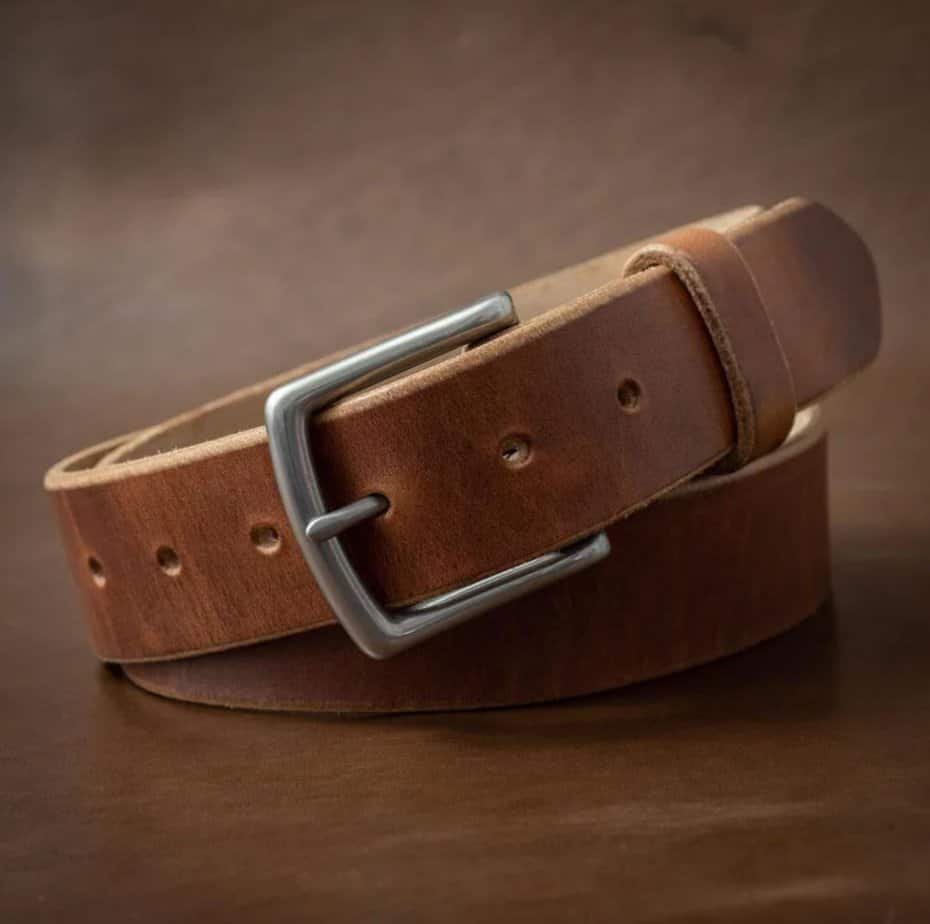
This English Tan burnished belt might cost four or five times what a regular leather belt does, but that’s because it is meant to last a lifetime. Burnished full grain leather is when the finished product is smoothed through an application of friction that antiques the color. Metal tools like spinning disks are used to apply pressure to the product to achieve this effect.
If you’ve ever made your own belt, you’ve probably used a metal tool to burnish the edges (soften and smooth them instead of letting them stay nappy and unfinished). This is pretty common for the edges of leather belts, but only high-end products will use it across the entire belt.
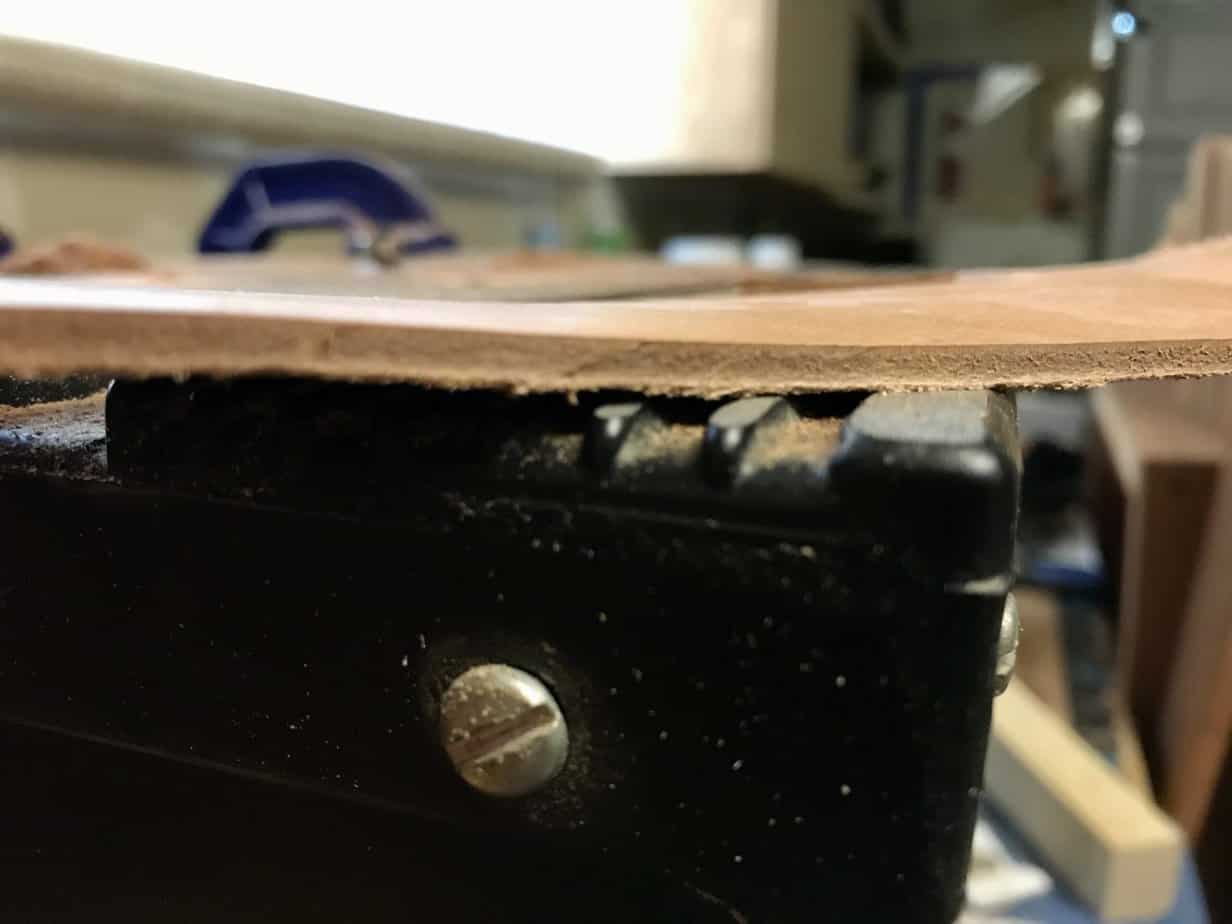
Image from Lacey Jackson
In the image above, you can see an unfinished edge for one of my homemade leather belts.
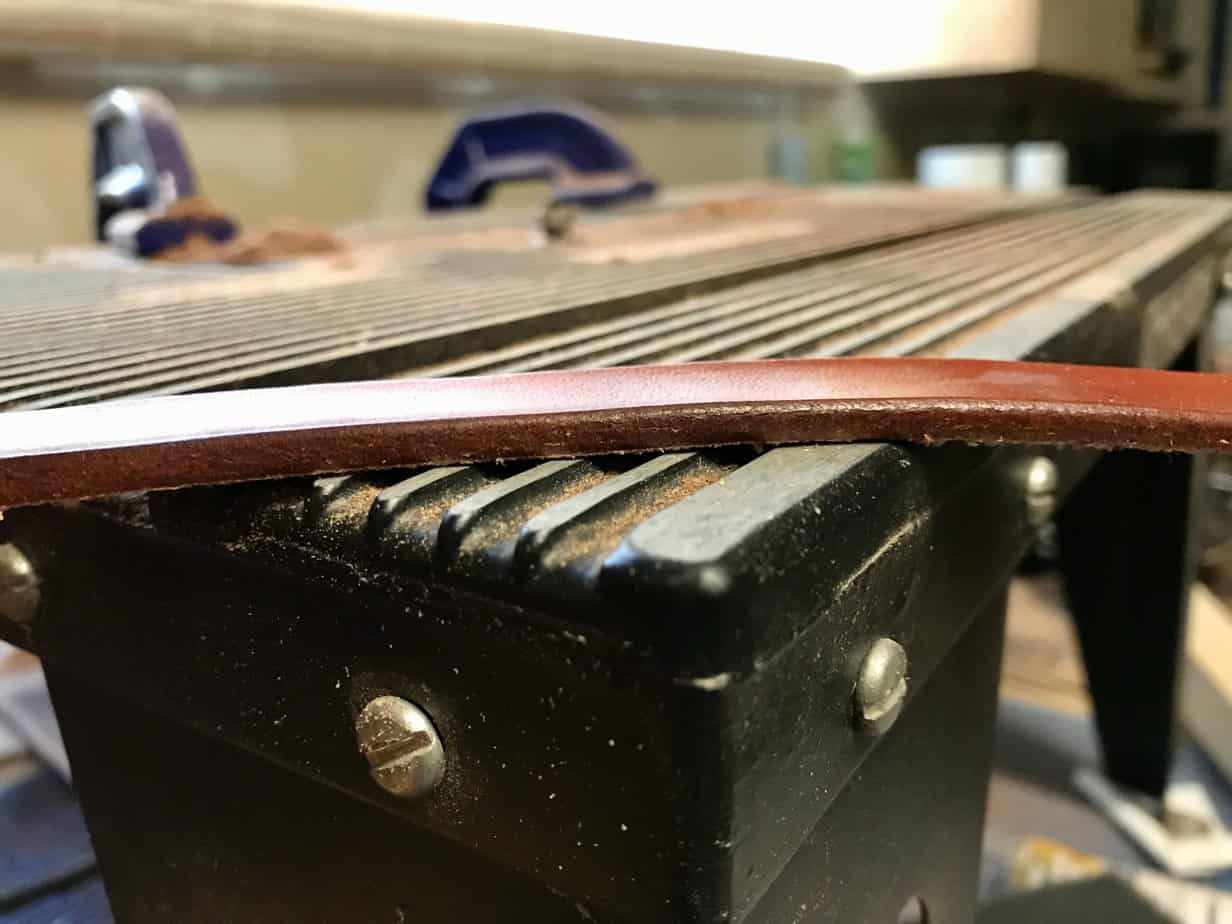
Image from Lacey Jackson
And in this second image, you can see what the burnished edge looks like, darkening and smoothing out the nappy edge.
Oiled

Sometimes you find full grain leather products like these Men’s work boots described as “oiled.” Oiled full grain leather is still full grain leather. It just means the exterior has been coated with:
- Raw oil and/or
- Emulsified oils and/or
- Penetrating aids.
Oiling the leather makes it more water resistant, and the material flexes more. That is why it is common in work boots and other outdoor products that need a lot of flex, as opposed to purses that don’t need any flex.
Tumbled
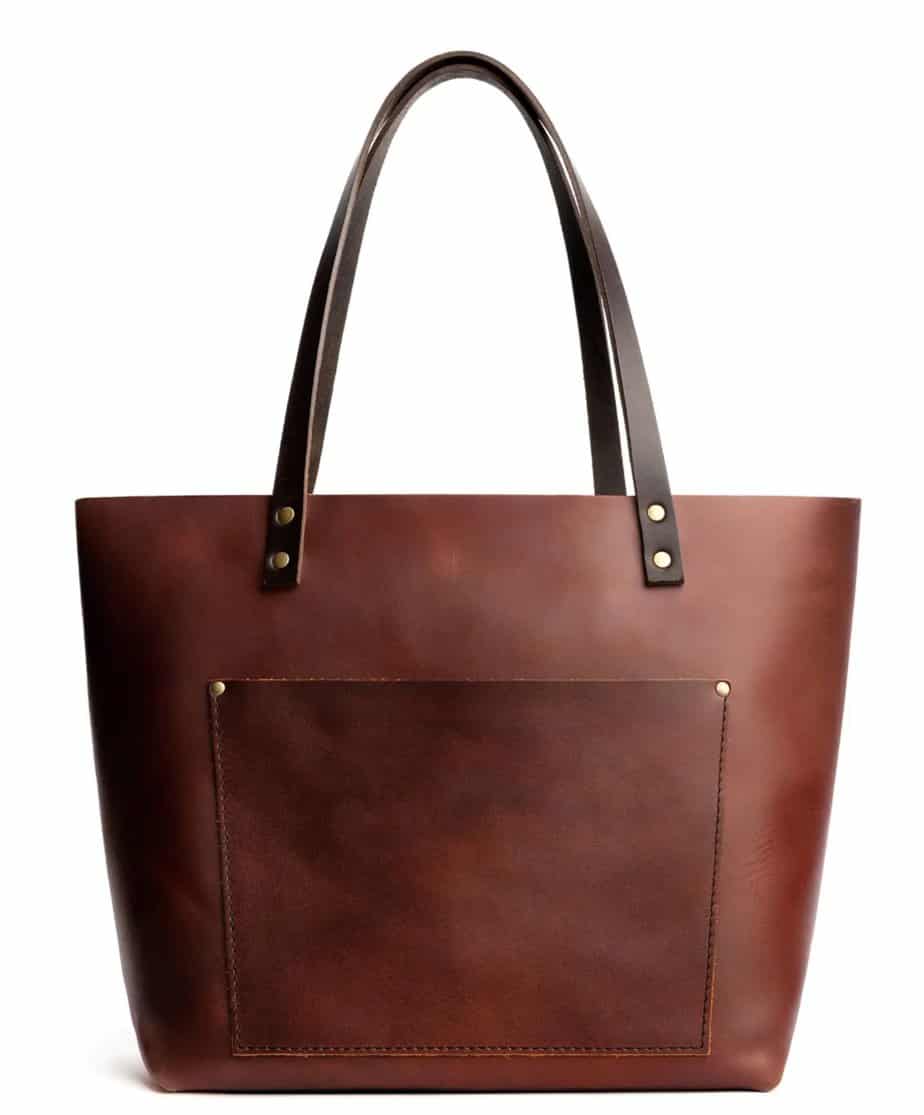
You might see a product listed as tumbled full grain leather. These Portland leather bags are tumbled full grain leather. Tumbled means exactly what you think: the tumble dry setting on a dryer.
Companies put the leather in a drum and tumble it around to make it softer and smoother and bring out the grain pattern.
Maintaining Full Grain Leather

If you have full grain leather gloves (as these Cashmere lined, quilted gloves which are to die for or these equally superb lamb leather Harris gloves *adds to cart*), bags, purses, boots, jackets, or furniture, maintenance isn’t as complicated as you might think.
It all starts with giving your leather products a good wipe-down regularly. Wipe down your bag, boots, or anything else with a clean, dry cloth now and again, if you:
- Notice dust or dirt on the outside,
- Find yourself outside in inclement weather,
- Drop the products in muck,
- Or just wear them while using public transit,
You don’t necessarily need to see dirt or grime on your full grain leather to benefit from a good wipe-down.
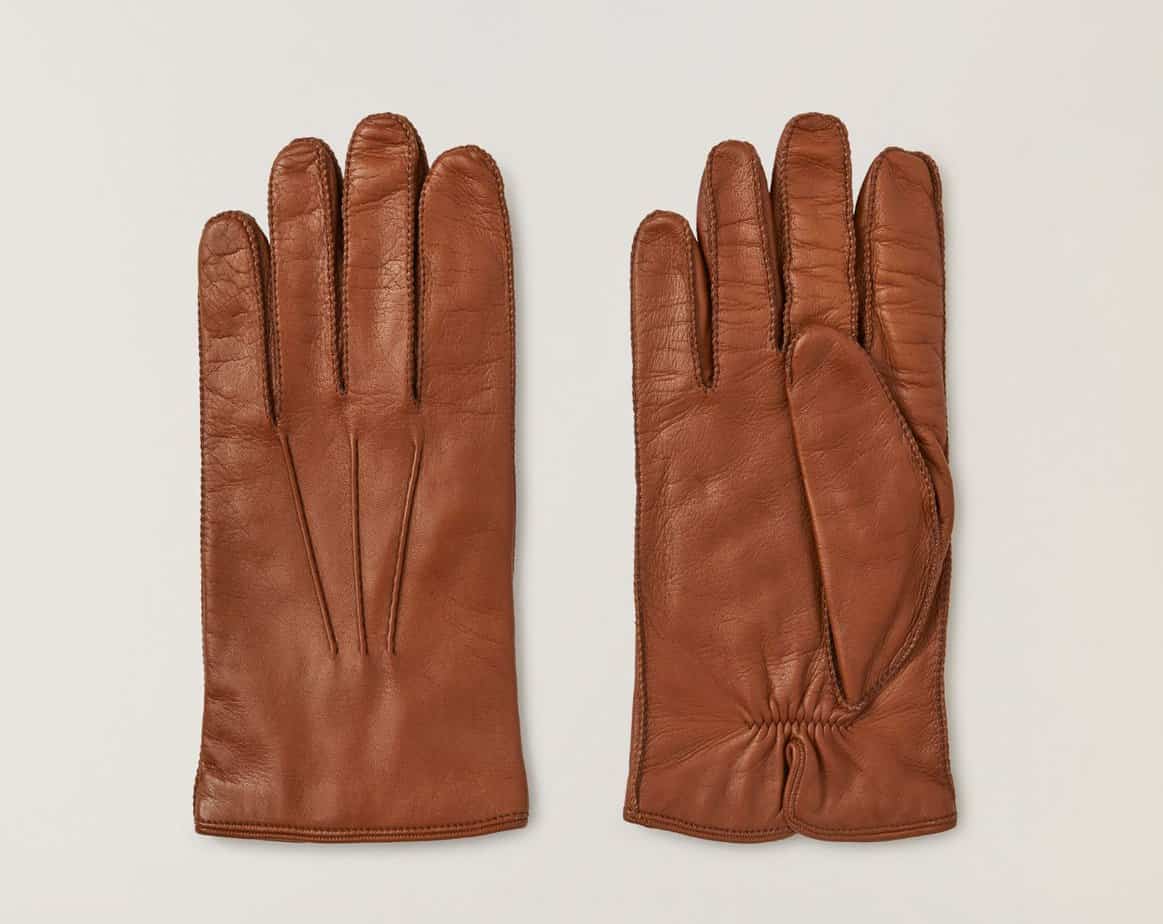
If your leather products get wet, let them dry immediately. You can, for example, try to soak up any residual water with a clean, dry cloth, but don’t ever use a hair dryer or put your leather on a heater to expedite the process.
If you can, store your full grain leather products in a room with humidity control. Remember, leather is hide, and just as you don’t want your skin to dry out, you don’t want the hide to dry out, either.
You can literally find hundreds of different leather products to clean, waterproof, shampoo, and condition your products. Most of them get rubbed onto the surface and are left to be absorbed by the leather, just as you put lotion on your hands and leave it to be absorbed by your skin.
Note: With any leather cleaning or care product, you should test it on an inconspicuous area of your leather product first, let it sit for 24 hours, and verify that it won’t alter the color too much. I’ve had leather boots I brought in for a thorough, professional cleaning, and the product they used changed the color of my leather. It wasn’t the end of the world, but it would have been nice had they warned me.
Protecting Full Grain Leather
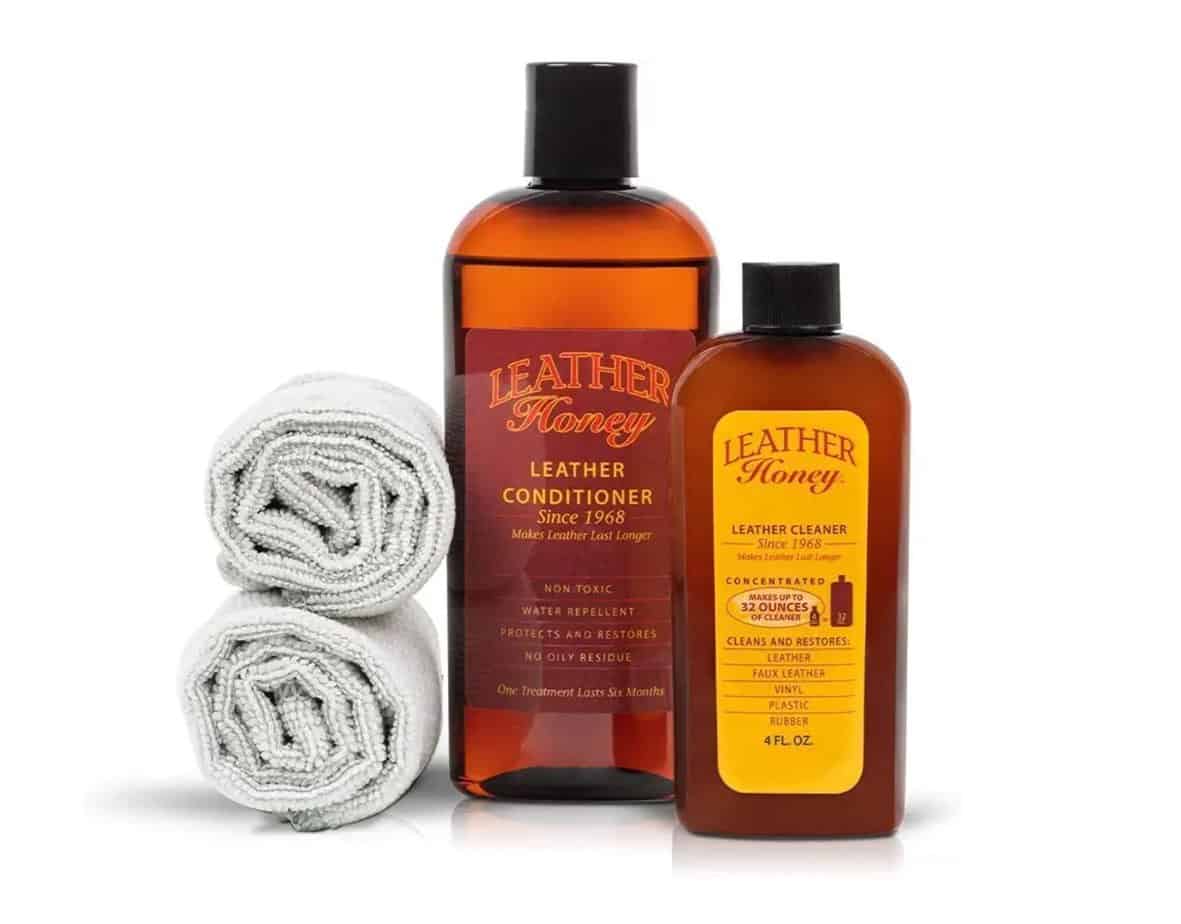
You can use leather protectants and sealants to stop the natural oils in your leather from escaping over time. If you don’t oil the leather regularly or apply things like cleaners and conditioners, any product you have will dry out with time, and this leads to cracking and breaking. Leather Honey is a very popular brand for leather cleaners and conditioners. Other popular brands include the French company Saphir.
Water and Full Grain Leather
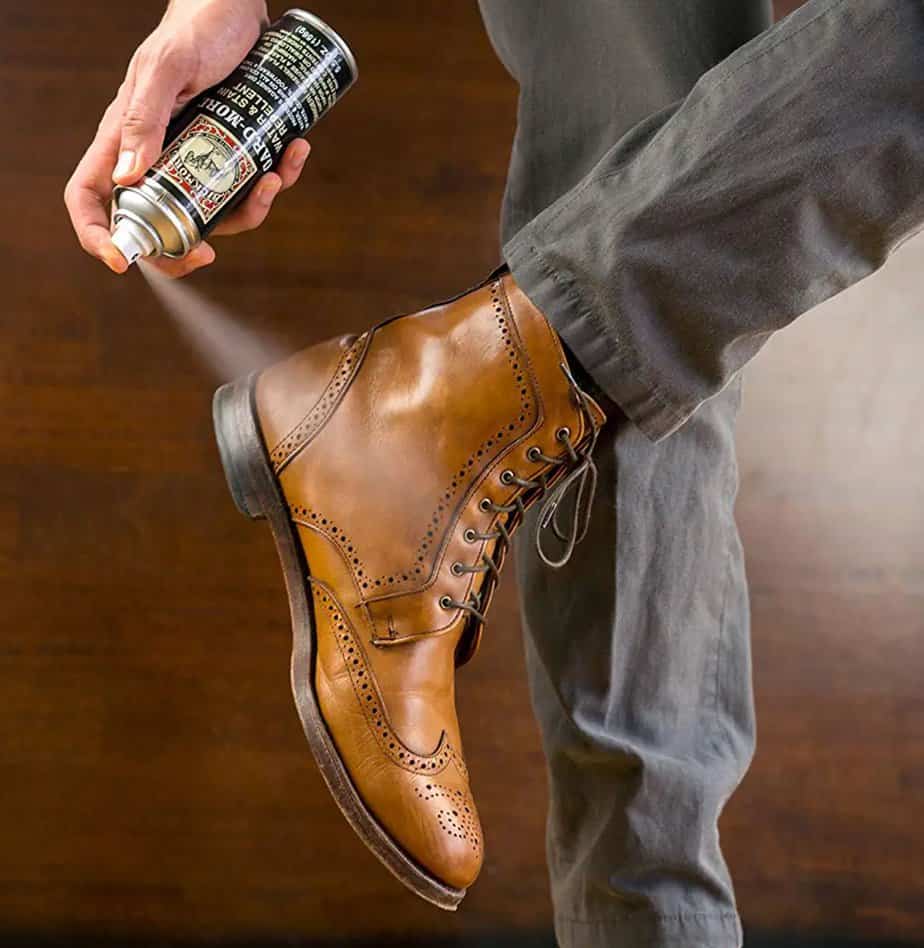
Leather is permeable no matter what type of leather you have. This means no piece of leather is 100% waterproof. However, with full grain leather, you have a thicker piece of material that is more water-resistant compared to a thinner, weaker section of split leather.
Thankfully, you can oil full grain leather products with things like spray protectors such as Bickmore to make it more waterproof and stainproof. Be advised: some spray protectors can change the natural color of your leather, so always test it on an inconspicuous area first.
Nikwax and YeezySolution are equally popular waterproofing products. The latter comes with a foam cleaning shampoo, spray, and brush for a deep clean.
FAQ
Question: How long does full grain leather last?
Question: Is full grain leather upper different from full grain leather?
Question: How thick is full grain leather?
Answer: Again, the term full grain leather can be misleading because it refers to so many different parts of the rawhide, depending on the manufacturer. The thickness will vary depending on whether or not it was split.
Question: Is corrected leather the same as full grain leather?
Answer: No. Full grain leather has no buffing or sanding applied to it. If you see something listed as “corrected,” this means that blemishes on the top layer have been removed through buffing or sanding. There is nothing wrong with corrected leather; it just means that there was an imperfection that the manufacturer altered in order to create a uniform appearance across the leather product.
Another way to look at it is to think of your own skin; you probably have a scar from an injury growing up or a mark on your skin from a particularly bad bug bite, and animals are no different. So, when a piece of hide is prepared, manufacturers find some sort of scar from an injury or an insect bite, and they smooth it over so that it has a uniform appearance.
Question: Are bonded leather products the same as full grain?
Answer: No, bonded leather is effectively the chicken nugget of the leather world; it is all the scraps of genuine leather blended together to create a sheet of workable leather. Bonded leather is usually embossed with an exterior print that makes it look like authentic leather grain you would get in full grain leather. Bonded leather is not only much lower quality but is also difficult to repair over time.
Question: How is full grain leather different from top grain or split?
Answer: When a rawhide is split into two sections, it produces the 1) top grain layer and 2) the split layer. The top grain layer is often used for nubuck leather products, while the split leather layer is often used for suede products. Full grain leather, by comparison, is a rawhide that has not been split.
Question: Is genuine leather the same as full leather?
Answer: The term “genuine” leather can be equally misleading because, in theory, it refers to anything with genuine leather. But in reality, it is usually applied to items made from weaker split grain leather. So people look at the term “genuine” and believe it is the highest quality leather. Full grain is actually the highest quality leather, so this is the label you want to look for specifically with your leather products.
Bottom Line
Authentic full grain leather is the best of the best. It is comprised of the entire hide, just not a portion of it, which means it is more durable and long-lasting. Care and maintenance are a breeze; apply some conditioner now and again and keep it away from water. If you invest in good full grain leather products, invest in some products for long-term care.
Looking for more interesting readings? Check out:
Kết thúc
Ngoài các bài viết tin tức, bài báo hàng ngày của Ngọc Quang, nguồn nội dung cũng bao gồm các bài viết từ các cộng tác viên chuyên gia đầu ngành về chuỗi kiến thức thời trang được chia sẽ chủ yếu từ nhiều khía cạnh liên quan chuỗi kiến thức này. https://vietnamleather.com/ là tạp chí thời trang trẻ, xu hướng thời trang mới của giới trẻ hiện đại. Phong cách thời trang đa dạng, phong phú, phù hợp phong cách giới trẻ hiện nay. Bạn có thể dành thời gian để xem thêm các chuyên mục nội dung chính với các bài viết tư vấn, chia sẻ mới nhất, các tin tức gần đây từ chuyên gia và đối tác của Chúng tôi. Cuối cùng, với các kiến thức chia sẻ của bài viết, hy vọng góp phần nào kiến thức hỗ trợ cho độc giả tốt hơn trong hoạt động nghề nghiệp cá nhân!
* Ý kiến được trình bày trong bài viết này là của tác giả khách mời và không nhất thiết phải là Ngọc Quang. Nhân viên tác giả, cộng tác viên biên tập sẽ được liệt kê bên cuối bài viết.
Trân trọng,
Các chuyên mục nội dung liên quan

